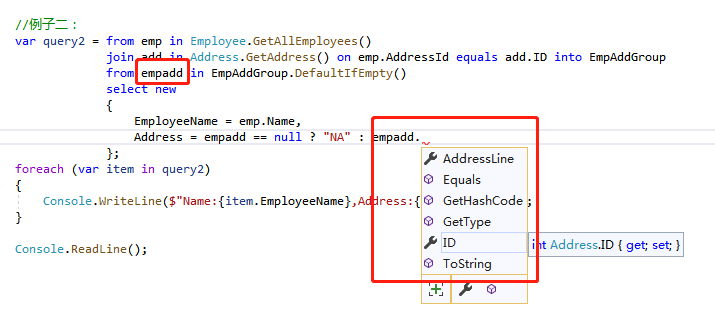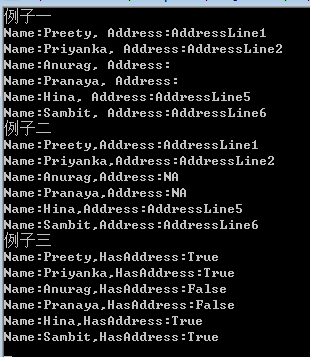LINQ 左连接(Left Join)
1. 数据准备
using System.Collections.Generic; namespace LINQTutorial { public class Employee { public int ID { get; set; } public string Name { get; set; } public int AddressId { get; set; } public static List<Employee> GetAllEmployees() { return new List<Employee>() { new Employee { ID = 1, Name = "Preety", AddressId = 1}, new Employee { ID = 2, Name = "Priyanka", AddressId =2}, new Employee { ID = 3, Name = "Anurag", AddressId = 0}, new Employee { ID = 4, Name = "Pranaya", AddressId = 0}, new Employee { ID = 5, Name = "Hina", AddressId = 5}, new Employee { ID = 6, Name = "Sambit", AddressId = 6} }; } } public class Address { public int ID { get; set; } public string AddressLine { get; set; } public static List<Address> GetAddress() { return new List<Address>() { new Address { ID = 1, AddressLine = "AddressLine1"}, new Address { ID = 2, AddressLine = "AddressLine2"}, new Address { ID = 5, AddressLine = "AddressLine5"}, new Address { ID = 6, AddressLine = "AddressLine6"}, }; } } }
2.左连接查询写法
using System; using System.Linq; namespace LINQTutorial { class Program { static void Main(string[] args) { //例子一: var query = from emp in Employee.GetAllEmployees() join add in Address.GetAddress() on emp.AddressId equals add.ID into EmpAddGroup from empadd in EmpAddGroup.DefaultIfEmpty() select new { emp, empadd }; foreach (var item in query) { Console.WriteLine($"Name:{item.emp.Name}, Address:{item.empadd?.AddressLine}"); } //例子二: var query2 = from emp in Employee.GetAllEmployees() join add in Address.GetAddress() on emp.AddressId equals add.ID into EmpAddGroup from empadd in EmpAddGroup.DefaultIfEmpty() select new { EmployeeName = emp.Name, Address = empadd == null ? "NA" : empadd.AddressLine }; foreach (var item in query2) { Console.WriteLine($"Name:{item.EmployeeName},Address:{item.Address}"); } Console.ReadLine(); } } }
3.注意事项
如果有运用到左连接,一定要注意右表可能为空的判断。
个人猜测,其实empadd是代表右表:

4.延伸知识
如果要判断一个Employee是否有地址?HasAddress
//例子三:判断一个Employee是否有地址? Console.WriteLine("例子三"); var query3 = from emp in Employee.GetAllEmployees() join add in Address.GetAddress() on emp.AddressId equals add.ID into EmpAddGroup from empadd in EmpAddGroup.DefaultIfEmpty() select new { EmployeeName = emp.Name, HasAddress = empadd != null }; foreach (var item in query3) { Console.WriteLine($"Name:{item.EmployeeName},HasAddress:{item.HasAddress}"); }
5.测试结果

参考文献
https://dotnettutorials.net/lesson/left-outer-join-in-linq/
自己写的代码在:CSharpBasic\LINQTutorial
本文来自博客园,转载请注明原文链接:https://www.cnblogs.com/keeplearningandsharing/p/16620651.html



 浙公网安备 33010602011771号
浙公网安备 33010602011771号